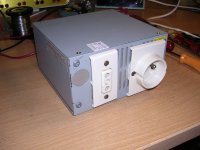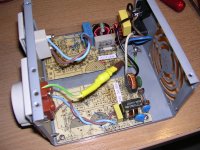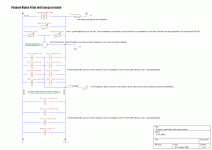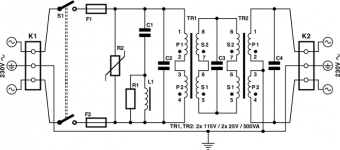The problem with filters is that you need to have it designed for the application, else what happens is what audiophiles say - conditioners change the sound signature of the setup.
So for this case the filter would work with that washing machine, but would it work well with your device, who knows.
Schematics for line filters are pretty standard anyways, it's the values that are unique.
Or if you're not picky and can live with the uncertainty, the local parts shop should have these line filters salvaged from dead products selling cheap, some of them rather big and heavy.
So for this case the filter would work with that washing machine, but would it work well with your device, who knows.
Schematics for line filters are pretty standard anyways, it's the values that are unique.
Or if you're not picky and can live with the uncertainty, the local parts shop should have these line filters salvaged from dead products selling cheap, some of them rather big and heavy.
Hi,
I just read the thread today. I have made recently mains conditioners from dead PC power supply (no DC output). I removed all components excepted the main filter. I made two conditioners from 2 PC dead PS and put them together in the same box. I connected the CD player on one conditioner and preamp on the other. I feel that the sound is better, more details, more bass, good stereo image.
I am happy with it since it costs almost nothing to me just work.
Cheers,
I just read the thread today. I have made recently mains conditioners from dead PC power supply (no DC output). I removed all components excepted the main filter. I made two conditioners from 2 PC dead PS and put them together in the same box. I connected the CD player on one conditioner and preamp on the other. I feel that the sound is better, more details, more bass, good stereo image.
I am happy with it since it costs almost nothing to me just work.
Cheers,
Is there someone who knows a good project for mains conditioner.(220-230v)
Hi,
You can use an elektor project, the 070135-17, issue Oct 2007 (UK)
Folks:
I've looked at Lukasz' "Silk 230 AC Filter" (AC filterr DIY ESA SILK) and it appears to be simple enough that even this newbie shouldn't screw it up. But I could still use a little advice -- can anyone offer recommendations on the ferrite ring and "finger type" ferrite rods needed in the design? Digikey has hundreds of ferrites (cores, slotted, etc.), all with differing impedances. What is the relevant criteria for picking ferrites for this filter -- for example, Lukasz recommends a "finger sized ferrite rod" that will have "3 turns of each wire" for L2 and L3.
Thank you,
Scott
I've looked at Lukasz' "Silk 230 AC Filter" (AC filterr DIY ESA SILK) and it appears to be simple enough that even this newbie shouldn't screw it up. But I could still use a little advice -- can anyone offer recommendations on the ferrite ring and "finger type" ferrite rods needed in the design? Digikey has hundreds of ferrites (cores, slotted, etc.), all with differing impedances. What is the relevant criteria for picking ferrites for this filter -- for example, Lukasz recommends a "finger sized ferrite rod" that will have "3 turns of each wire" for L2 and L3.
Thank you,
Scott
Hi Scott,
I also have looked at Lukasz "Silk 230 AC Filter" before making my filter. I have noticed that the mains input of a PC power supply arrangement is very similar to Lukasz filter design. That's why I made my filter from a recycled PC power supply. All components are already connected. Further more PC power supply can be found everywhere for nothing. My filter cost nothing just work. Dismantle a dead PC power supply you have everything you need inside. I have no idea of impedance values of coils but I am confident in the design and use it as is. I am happy with the result.
Cheers,
I also have looked at Lukasz "Silk 230 AC Filter" before making my filter. I have noticed that the mains input of a PC power supply arrangement is very similar to Lukasz filter design. That's why I made my filter from a recycled PC power supply. All components are already connected. Further more PC power supply can be found everywhere for nothing. My filter cost nothing just work. Dismantle a dead PC power supply you have everything you need inside. I have no idea of impedance values of coils but I am confident in the design and use it as is. I am happy with the result.
Cheers,
Is there someone who knows a good project for mains conditioner.(220-230v)
QSC dont recommend them for high power amps.
They say it adds an impedance into the power supply chain and can upset some amps.
Personally I use one on my disco for the audio side to stop clicks etc.
I run the lights through another extension to stop interference with the audio.
Looking at the Lampizator design, it has some good points - the small number of turns of heavy gauge wire for the inductors is a good thing, the inductor on the earth line ditto IMHO. The rest is a little bit of a dog's breakfast... In particular - DON'T put a switch in the Earth line, and ignore any suggestion of using non X or Y caps for mains work: potentially lethal errors!
As a rule it's fairly difficult to make a bad job of AC line filtering, something generally being better than nothing, so long as it's safe, and a few principles are borne in mind. Here's a few pointers based on building quite a few of the things
The main thing which catches people out is usually the inductors, the wrong choice literally "chokes" current supply, and large chokes can even be saturated by DC offset, making a bad situation even worse. I'd recommend buying chokes ready made - CPC Farnell do a good range. For amps I'd look for a common mode choke of no more than 10mH which can cope with at least 5 Amps of current, I use 0.5mH / 35 Amps (order code 1636306).
Use X-class caps across L/N and Y-class from L/N to earth. In the attached design I've cascaded values of each to give a reasonably wide range of RF attenuation frequencies.
I've included surge protection in the attached design, and this is cascaded to provide both speed of response (TVS / GDT) and prolonged response (MOV / GDT). Bear in mind the MOVs won't last indefinitely if you receive frequent or large transient events, so it's worth making your build easy to service.
Lastly - make sure all metal casework is earthed and PLEASE don't dick-about with mains voltages if you're not sure what you're doing - they and the fires they may cause kill.
Apologies that the attachment's a little on the large size - wanted it to be clear. Comments pro or con received with interest.
cheers
As a rule it's fairly difficult to make a bad job of AC line filtering, something generally being better than nothing, so long as it's safe, and a few principles are borne in mind. Here's a few pointers based on building quite a few of the things

The main thing which catches people out is usually the inductors, the wrong choice literally "chokes" current supply, and large chokes can even be saturated by DC offset, making a bad situation even worse. I'd recommend buying chokes ready made - CPC Farnell do a good range. For amps I'd look for a common mode choke of no more than 10mH which can cope with at least 5 Amps of current, I use 0.5mH / 35 Amps (order code 1636306).
Use X-class caps across L/N and Y-class from L/N to earth. In the attached design I've cascaded values of each to give a reasonably wide range of RF attenuation frequencies.
I've included surge protection in the attached design, and this is cascaded to provide both speed of response (TVS / GDT) and prolonged response (MOV / GDT). Bear in mind the MOVs won't last indefinitely if you receive frequent or large transient events, so it's worth making your build easy to service.
Lastly - make sure all metal casework is earthed and PLEASE don't dick-about with mains voltages if you're not sure what you're doing - they and the fires they may cause kill.
Apologies that the attachment's a little on the large size - wanted it to be clear. Comments pro or con received with interest.
cheers
Attachments
Related to this AC filter by Lukasz, can someone advise me please if this MOV is a suitable for this use or not.
LITTELFUSE|V275LA40BP.|METAL OXIDE VARISTOR, 369V 680V | element14 Singapore
Thanks!
this is a 369V MOV, try to find one rated for your supply voltage. Expect your worst case supply voltage to be ~135Vac for a 110/120Vac supplyRelated to this AC filter by Lukasz, can someone advise me please if this MOV is a suitable for this use or not.
LITTELFUSE|V275LA40BP.|METAL OXIDE VARISTOR, 369V 680V | element14 Singapore
Thanks!
I would use a 270Vac or 275Vac MOV on a 220/240Vac supply.
I stupidly bought a batch of 250Vac MOV before I found out how they were rated. They still lie on the shelf unused.
elektor 070135-17 Oct 2007 is a little bit more complex/expensive.
I've removed component values incase of copyright issues.
Regards
James
Search Ray´s page for the balanced mains filter. This one works with the same principles and looks simple enough to build: Ray's Audio Page
- Status
- This old topic is closed. If you want to reopen this topic, contact a moderator using the "Report Post" button.
- Home
- Amplifiers
- Power Supplies
- Mains conditioner



